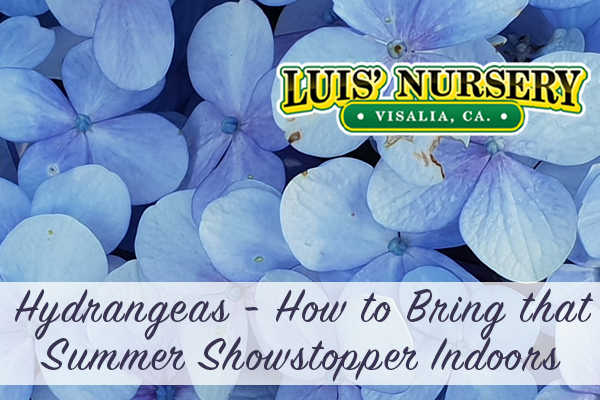As we trudge through winter some of us may long for the longer and warmer days of summer. We don’t have the power to speed up the clock, but we can certainly transform the spaces around us to feel more like summer. Hydrangeas are a well-known summer showstopper with their larger-than-life blooms and gorgeous colors. Sometimes people will purchase them as disposable houseplants for special occasions and toss them out afterward, but they are missing out on having lasting beauty on their table. You can grow hydrangeas indoors with proper care and patience. But how can you grow Hydrangeas indoors?
Important tip #1 – Choose the right variety
Not every hydrangea is up for the task of becoming your new indoor delight. You need to bring home the hardiest of hydrangeas. Which one you might ask? It is called the hydrangea macrophylla or the mophead hydrangea. Of course, it is! I mean, mops belong inside the house, right? This variety of hydrangea is well-suited for containers and easy to grow. Mophead hydrangeas bloom for months with their large bloom clusters and rich green leaves creating the perfect centerpiece for your winter table.
Important tip #2 – Water correctly
Hydrangeas require proper drainage, so a drainage hole is a must in the pot that you choose. Proper drainage prevents root rot and other fungal diseases that are just icky and harmful to your beautiful hydrangea. It’s important to not overwater your hydrangea. You can test the soil’s moisture level 3 inches into the soil. If the soil feels semi-dry you can water it thoroughly until the water runs out the bottom. Your water schedule will depend on how quickly the soil dries out and if the plant is blooming. If you see your flower heads drooping, they need a drink! After it is done blooming you should water it less, but it should never dry out. Your hydrangea will love you if you use distilled water or rainwater instead of chlorinated city water.
Important tip #3 – Let them have proper light
Even though hydrangeas are known for being shade lovers they need bright, indirect light to thrive. Careful placement of your plant will be beneficial to its survival. Choose a spot with plenty of light to keep them blooming, but not direct heat that will burn the leaves and blooms. Morning sunlight and gentle light throughout the day will keep your hydrangea smiling.
Important tip #4 – Choose the right soul and fertilizer
Did you know that you can control the color of the blooms (depending on the variety) based on the pH level of the soil? How cool is that? If you have a more acidic soil (5.5 or lower) you will have blue flowers. A pH level of 5.5 and 6.5 will create purple and pink blooms and a pH of 7 and up makes red blooms! Your hydrangea will thrive in well-drained and slightly acidic soil. Fertilize weekly during active blooming and once a month after bloom. You won’t need to feed them at all in early fall.
Important tip #5 – Take care when pruning
Not all varieties of hydrangea need the same amount of pruning and each variety will tell you when it needs pruned. The best time to prune is immediately after flowering stops. You will want to be careful not to prune at the wrong time and cut off new buds. You can remove spent flowers to help the plant look pristine. Pruning should be done to cut back dead and weak stems but take care to keep some so you will enjoy blooms again.
Hydrangeas aren’t for just outdoors anymore! You can enjoy them indoors and brighten up your living space. They can be taken outdoors later if you’d like after the frost has passed. Bringing flowers and plants indoors can improve your mood and the air quality of your home. If you’re looking for the perfect houseplant, please come on by the nursery and we can help you find your perfect match!

